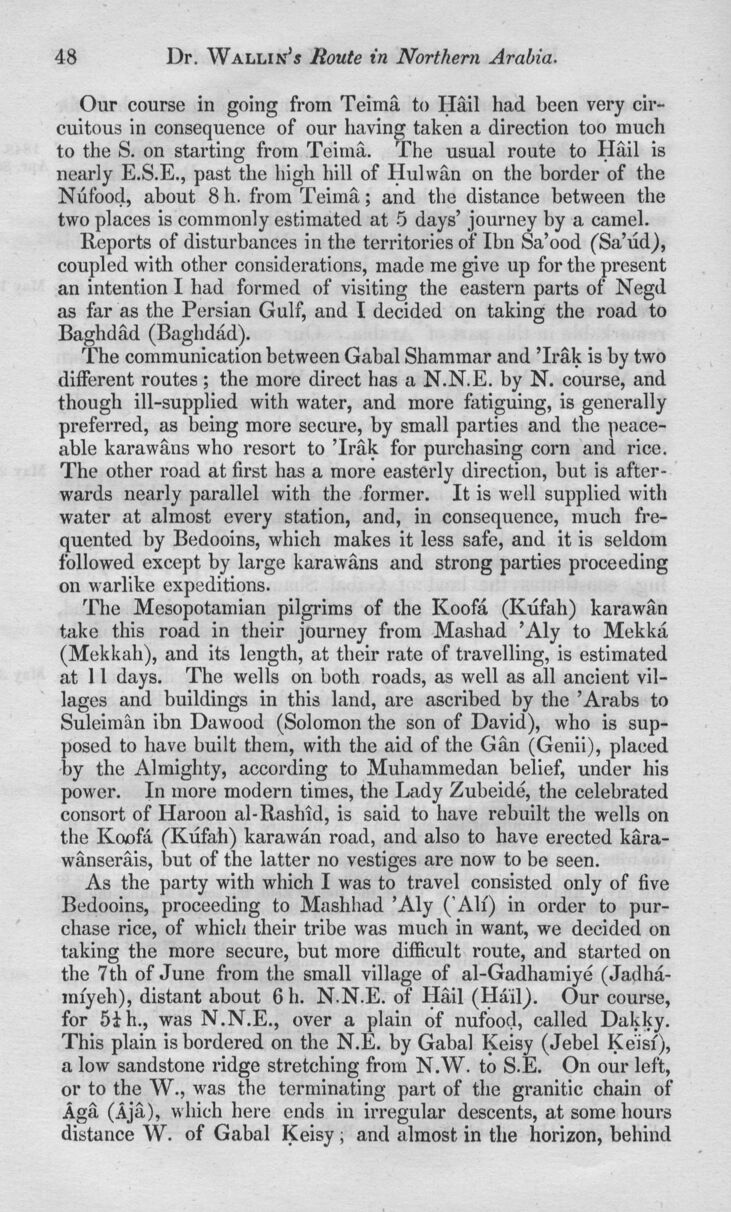
Full resolution (JPEG) - On this page / på denna sida - Route in Northern Arabia

<< prev. page << föreg. sida << >> nästa sida >> next page >>
Below is the raw OCR text
from the above scanned image.
Do you see an error? Proofread the page now!
Här nedan syns maskintolkade texten från faksimilbilden ovan.
Ser du något fel? Korrekturläs sidan nu!
This page has never been proofread. / Denna sida har aldrig korrekturlästs.
[-Our-]{+48
Ur. Wallin’s Route in Northern Arabia.
Our+} course in going from Teima to ITa.il had been very
circuitous in consequence of our having taken a direction too much
to the S. on starting from .Teima. The usual route to Hail is
nearly E.S.E., past the high hill of Hulwan on the border of the
Nufood, about 8h. from Teima; and the distance between the
two places is commonly estimated at 5 days’ journey by a camel.
Reports of disturbances in the territories of Ibn Sa’ood (Sa’tid),
coupled with other considerations, made me give up for the present
an intention 1 had formed of visiting the eastern parts of Negd
as far as the Persian Gulf, and I decided on taking the road to
Baghdad (Baghdad).
The communication between Gahal Shammar and ’Irak is by two
different routes; the more direct has a N.N.E. by N. course, and
though ill-supplied with water, and more fatiguing, is generally
preferred, as being more secure, by small parties and the
peaceable karawaus who resort to ’Irak for purchasing corn and rice.
The other road at first has a more easterly direction, but is
afterwards nearly parallel with the former. It is well supplied with
water at almost every station, and, in consequence, much
frequented by Bedooins, which makes it less safe, and it is seldom
followed except by large karawans and strong parties proceeding
on warlike expeditions.
Tiie Mesopotamian pilgrims of the Koofa (Kufah) karawan
take this road in their journey from Masliad ’Aly to Mekka
(Mekkah), and its length, at their rate of travelling, is estimated
at 11 days. The wells on both roads, as well as all ancient
villages and buildings in this land, are ascribed by the ’Arabs to
Suleiman ibn Dawood (Solomon the son of David), who is
supposed to have built them, with the aid of the Gan (Genii), placed
by the Almighty, according to Muhammedan belief, under his
power. In more modern times, the Lady Zubeide, the celebrated
consort of Haroon al-Bashid, is said to have rebuilt the wells on
the Koofa (Kufah) karawan road, and also to have erected
kara-wanserais, but of the latter no vestiges arc now to be seen.
As the party with which I was to travel consisted only of five
Bedooins, proceeding to Mashhad ’Aly ( All) in order to
purchase rice, of which their tribe was much in want, we decided on
taking the more secure, but more difficult route, and started on
the 7th of June from the small village of al-Gadhamiye
(Jadha-miyeh), distant about 6h. N.N.E; of Hail (Hail). Our course,
for 5ih., was N.N.E., over a plain of nufood, called Dakky.
This plain is bordered on the N.E. by Gahal Keisy (Jebel Keisf),
a low sandstone ridge stretching from N.W. to S.E. On our loft,
or to the W., was the terminating part of the granitic chain of
Aga (Aja), which here ends in irregular descents, at some hours
distance W. of Gabal Keisy; and almost in the horizon, behind
<< prev. page << föreg. sida << >> nästa sida >> next page >>